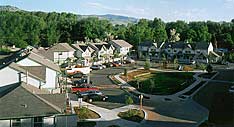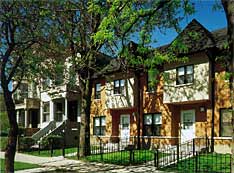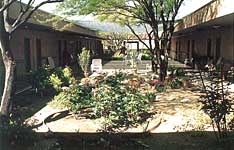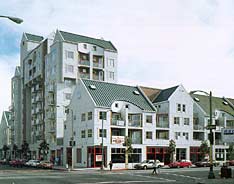|
Meets the user's needs
Well designed projects understand the needs of their occupants and how these needs impact physical design. Families with children may need larger homes with more bedrooms, larger kitchens and more storage. Elderly people living alone, on the other hand, may need less space, but will require more of that space to be designed with accessibility issues in mind. Social services may be more important to the elderly, daycare services may be critical to families.
Occupant needs such as these can be cost-effectively met by design, but only if they are identified early on in the process and not forgotten along the way. The Design Advisor has been developed to help guide and optimize this process (see 20 Steps to Design Quality).
It is important to remember that, while occupant needs are a critical consideration, some design flexibility must also be maintained to allow for changes in use over time. As a general rule, a design should avoid elements that actively interfere with the specific use patterns of target occupants, but not be so specific that every detail is driven by occupant needs.
 |  |
This Boulder, Colorado development was planned with its occupants - single parent families - in mind. Building clusters surround a central green space, creating a sense of community and a place for children to play. Parking is near the front door of each unit, making it easy to get kids and groceries from car to home. And kitchen sinks are located at front windows so that children can be watched while playing.
(Woodlands)
|
These Chicago townhouses were specially designed for large families. 75% of the units have 3 or 4 bedrooms, which is rare in affordable housing developments. One resident praised the homes because, "They are large, with lots of cabinet space, lots of storage, and light everywhere!"
(West Town Cluster)
|
 |  |
The site for this Tuscon, Arizona development was perfect for its target occupants: the elderly and people with disabilities. It is next to a facility offering health and social services, across the street from a large, full service shopping center, and one block from the city's main hospital. The location is a boon for residents who do not or cannot afford to drive automobiles.
(Viviendas Asistenciales)
|
Occupant input was critical to the success of this Oakland, California development. As the project manager noted, "User input is necessary to long-term success. The more opportunity those who are effected by the project have to comment on it, the better the facility will function. I am guaranteed of making a mistake if I assume instead of ask what will work for the future residents or the maintenance personnel."
(Frank G. Mar Housing)
|
|
For a thorough guide to current Federal requirements for universal access - together with information on other, voluntary accessibility design tools - please refer to the resources in HUD's Office of Fair Housing and Equal Opportunity at www.hud.gov/fairhousing
|



